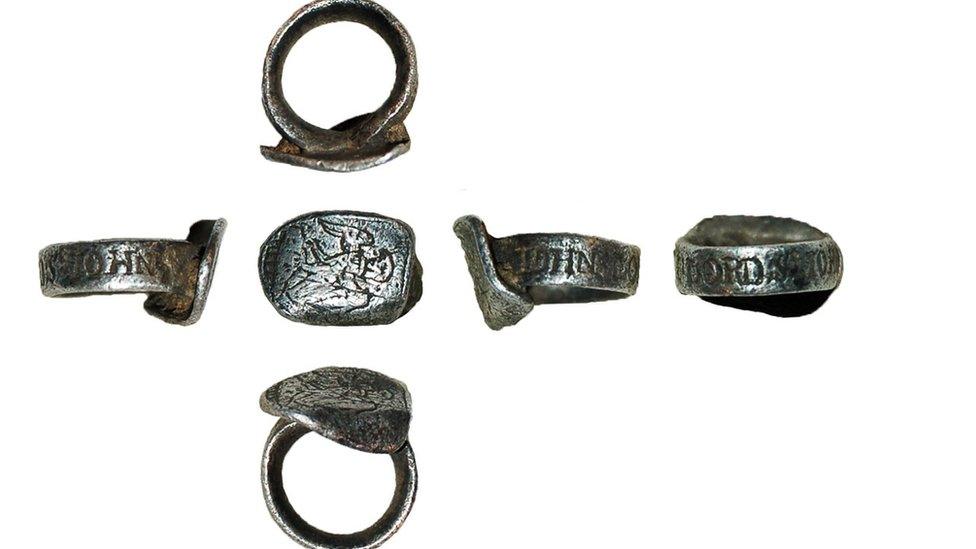Medieval matrix and Tudor ring belonged to 'higher status' people
- Published

The hawking ring was discovered in Bletsoe on 1 December 2018
Medieval and Tudor silver artefacts dug up by detectorists in two Bedfordshire villages belonged to "higher status" people, experts believe.
A seal matrix was found in Wilden near Bedford in 2017, while a hawking ring was dug up in Bletsoe a year later.
Peter Reavill, officer for the Portable Antiquities Scheme, said the seal was made for a merchant or landowner.
Ian Richardson, treasure registrar at the British Museum, said they "add more to our knowledge of the past".
He said the ring, or vervel, external, dated from 1550-1560 and would have been tied to a falcon's leg to identify its owner.
'Upper class'
He said it was not very "common" as only 100 had been reported under the Treasure Act since 1997.
It belonged to Lord St John of Bletsoe, who was "upper class", and was similar to a vervel found in the area more than 20 years ago.
"This doesn't appear to be the matching twin to the earlier vervel, so it speaks to either the longevity or the breadth with which falconry was practised by the St Johns," he said.

The silver seal matrix is 23mm (0.9in) long, 16.5mm (0.65in) wide and weighs 6.17 grams (0.01 lbs)
The seal matrix, external would have been used to leave an imprint in the wax which was used to seal letters and other correspondence which would identify the sender.
It dates from the 13th-14th Centuries and the Anglo-French/Norman inscription can be interpreted as "I am true", Mr Reavill discovered.
He said: "It is one of the finest, is very deeply cut, has been produced in high quality material and is well-made by a skilled craftsman who understands the needs of the client."
They "usually belong to 'higher status' people such as merchants, landowners and the lower nobility", he added.
Both items, which were found by different people, were declared treasure by the senior coroner at a hearing for the Bedfordshire and Luton Coroner Service.
The Higgins museum in Bedford has "expressed provisional interest in acquiring these items, subject to valuations, and is awaiting further details before any final decision is taken", a spokeswoman for Bedford Borough Council said.

What is treasure?
Under the Treasure Act 1996, external, finders of potential treasure in England, Wales and Northern Ireland are legally obliged to notify their local coroner
An inquest then determines whether the finds constitute treasure
The act contains a number of definitions of "treasure", including prehistoric objects, coins that contain gold or silver and are at least 300 years old, or more recent valuable objects that have been deliberately hidden
Items are recorded by the Portable Antiquities Scheme, external, which is run by the British Museum and National Museum Wales
If the find is declared treasure by a coroner, the finder must offer it for sale to a museum at a price set by the British Museum's Treasure Valuation Committee
A reward is then offered to the finders and other relevant parties

- Published4 September 2019

- Published24 March 2019

- Published17 March 2019
